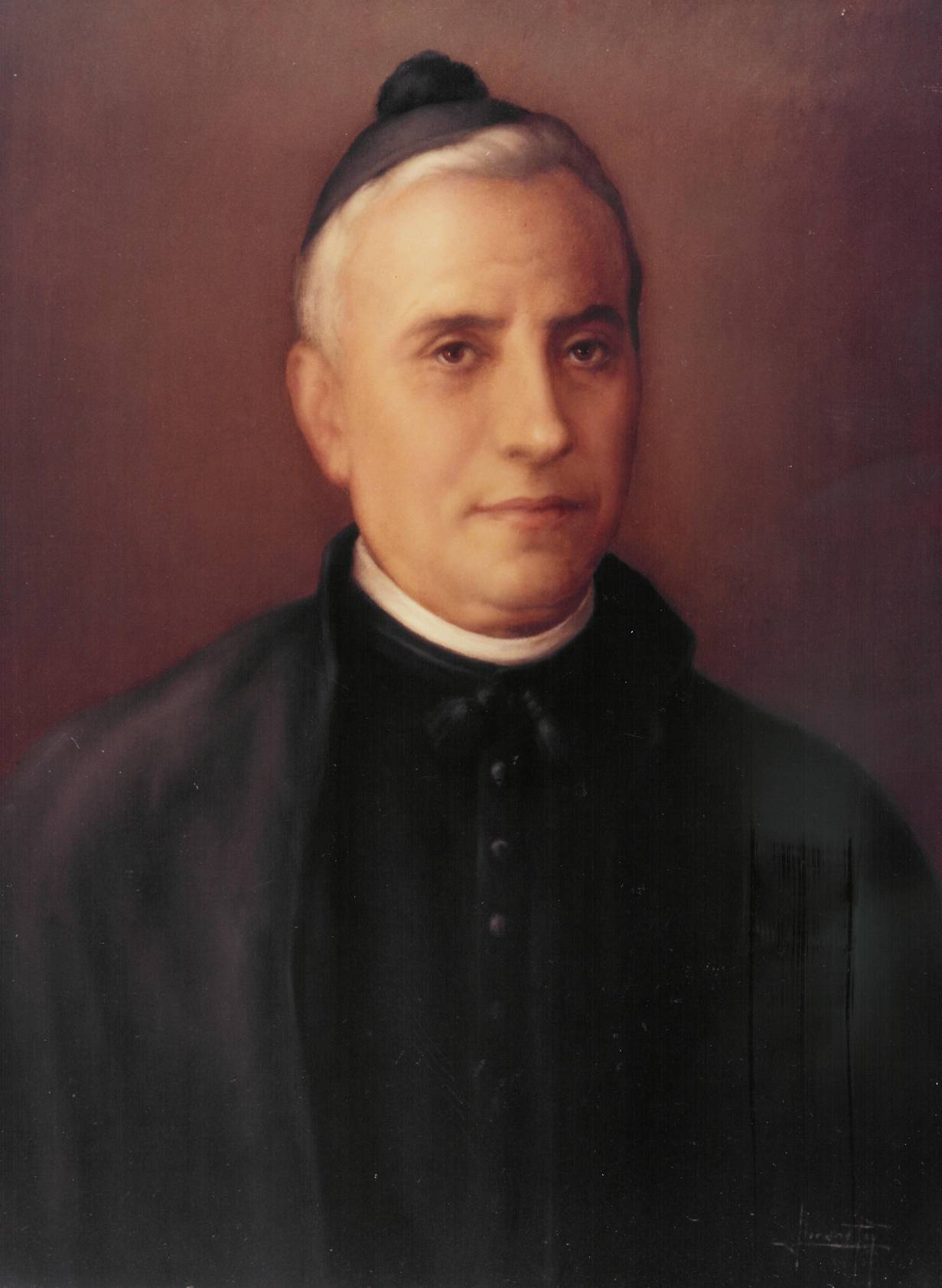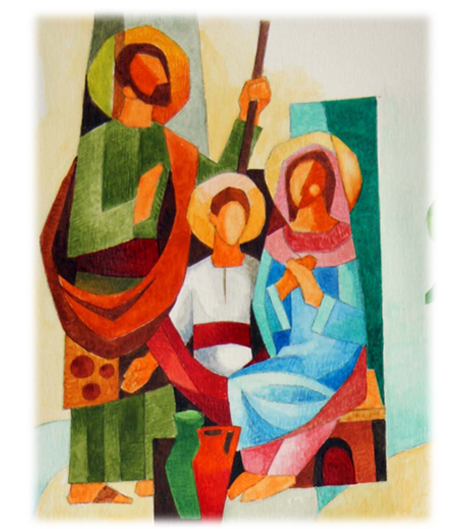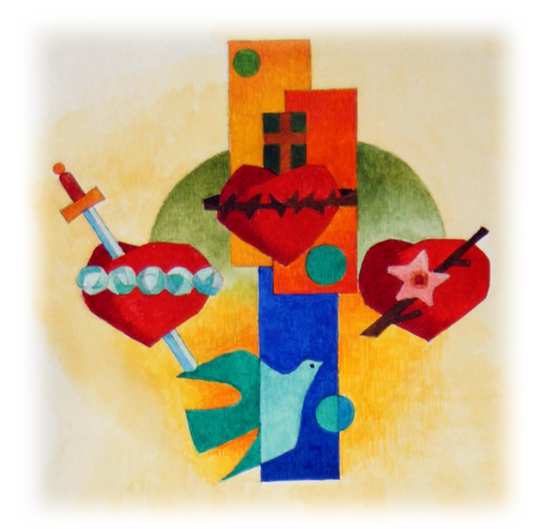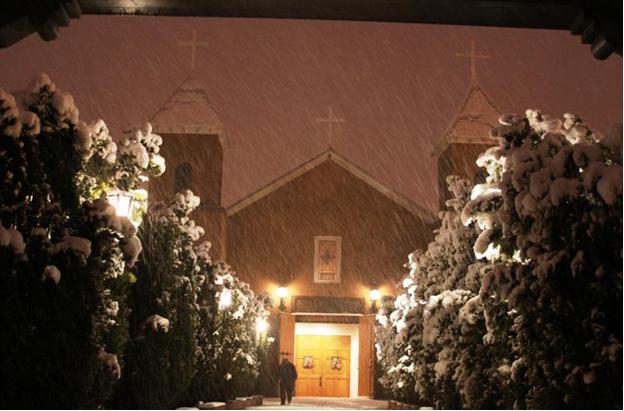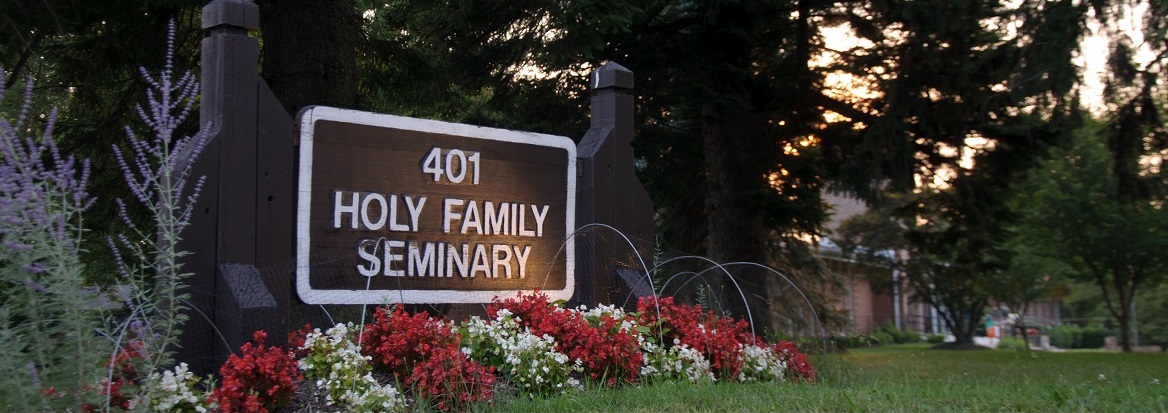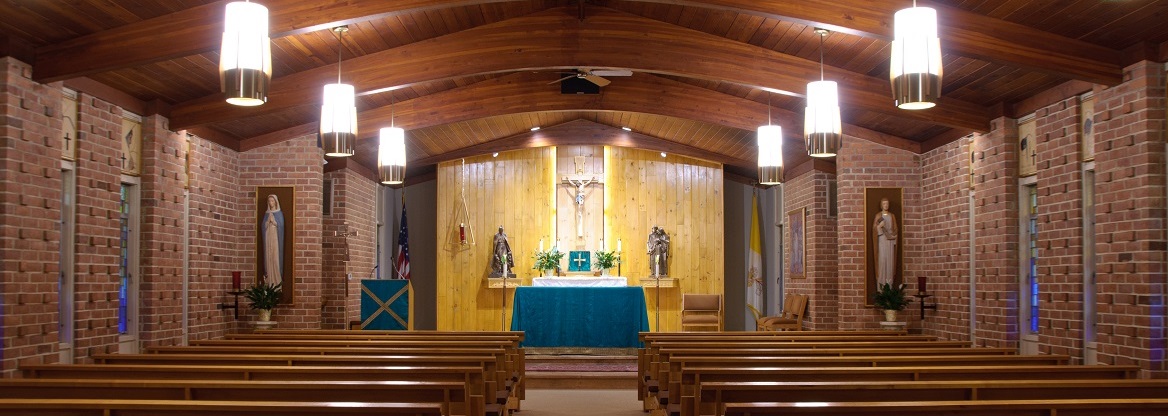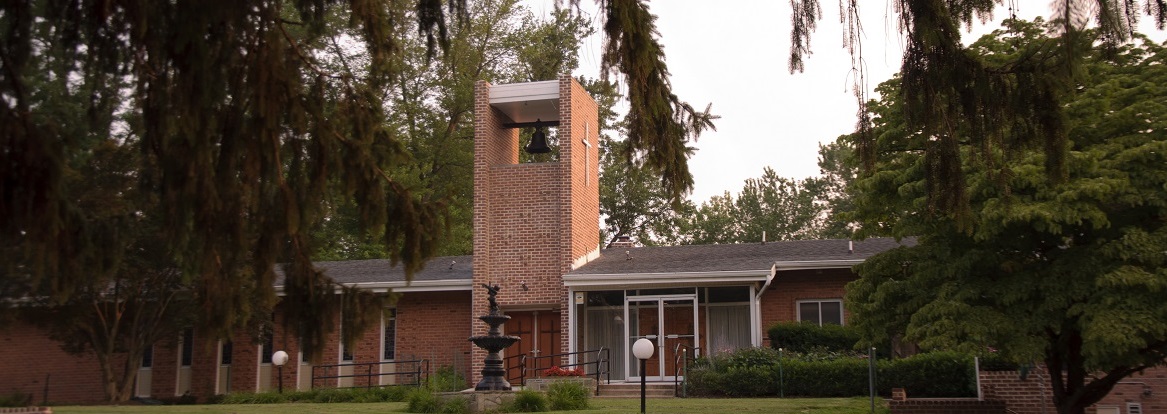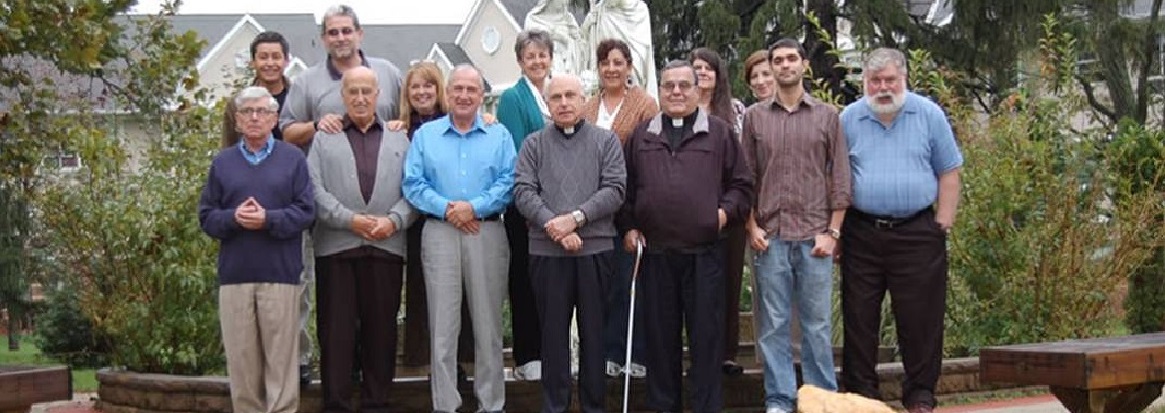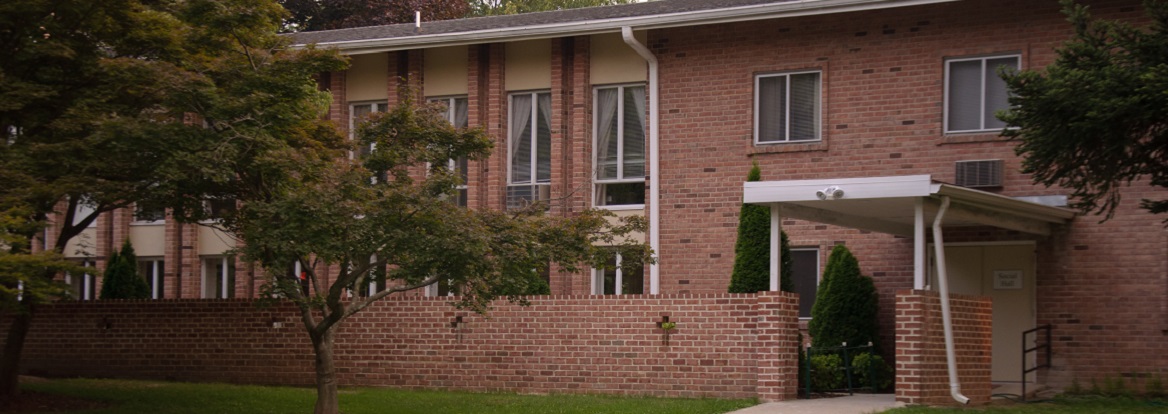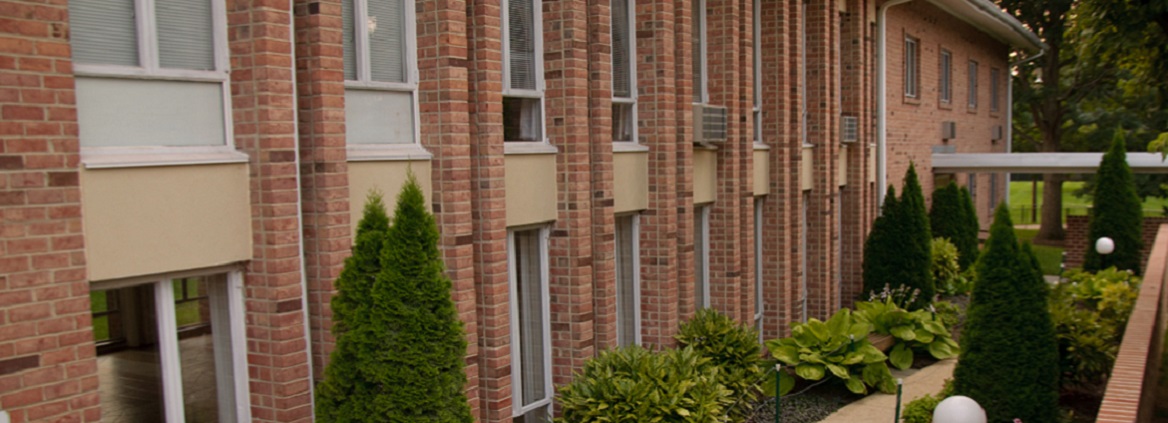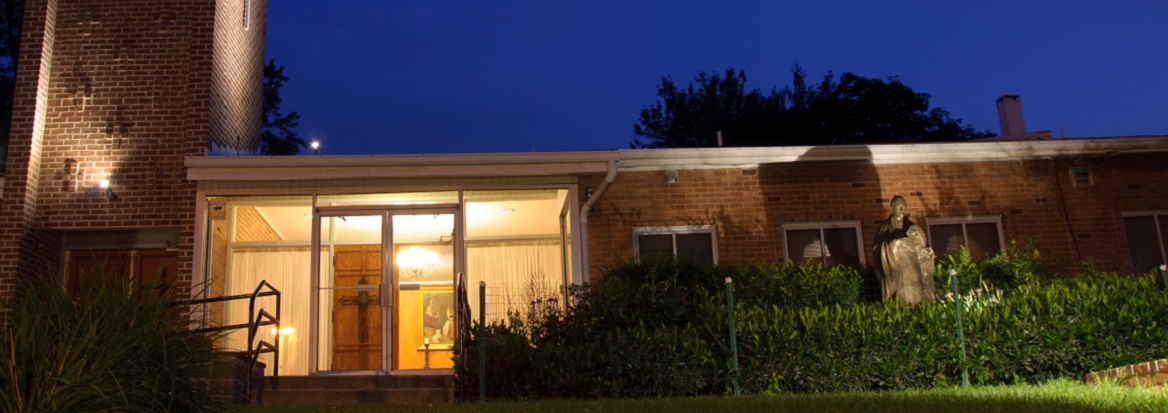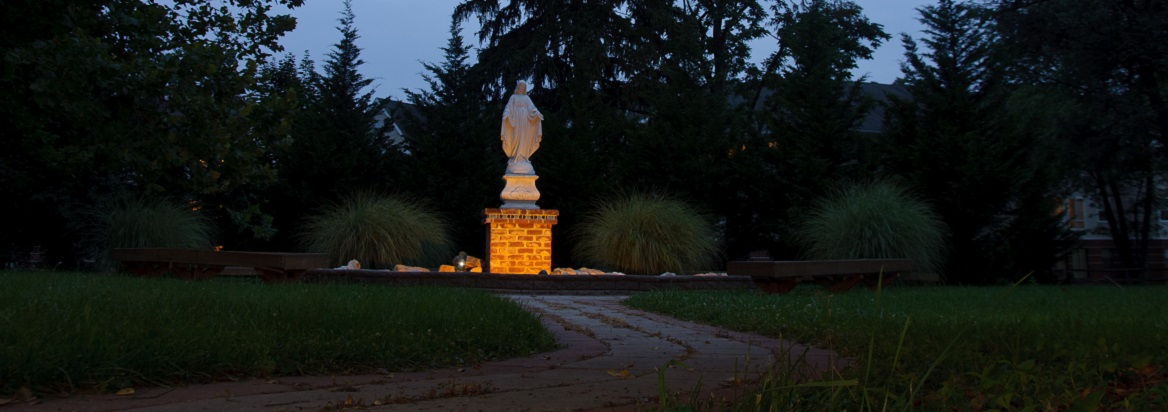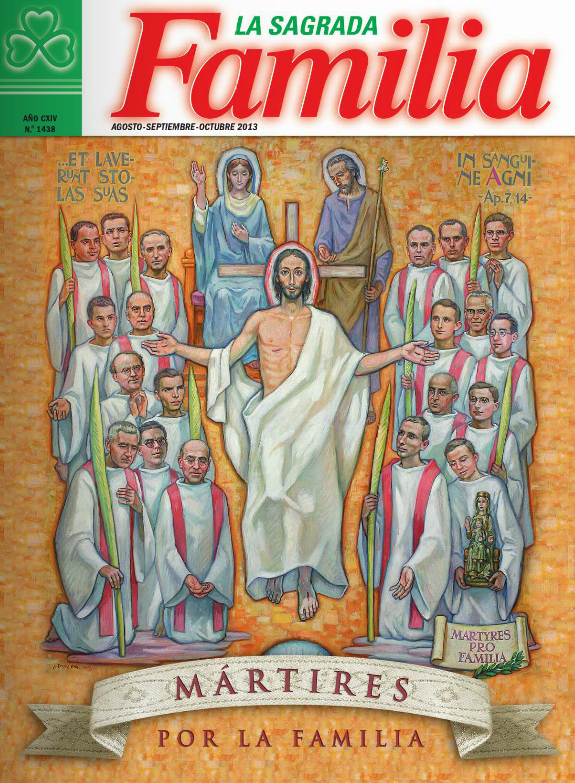
© 2009 by Sons of the Holy Family. All rights reserved
HOLY FAMILY SEMINARY
401 RANDOLPH ROAD SILVER SPRING, MD 20904
holyfamilyseminary@gmail.com
401 RANDOLPH ROAD SILVER SPRING, MD 20904
holyfamilyseminary@gmail.com


Holy
Family
Family
Holy
Holy
Family
Seminary
Seminary
Seminary
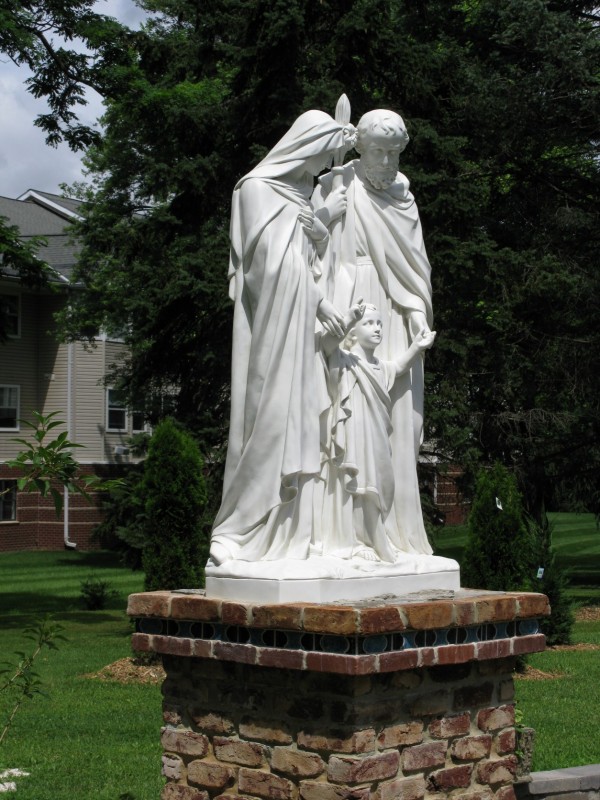

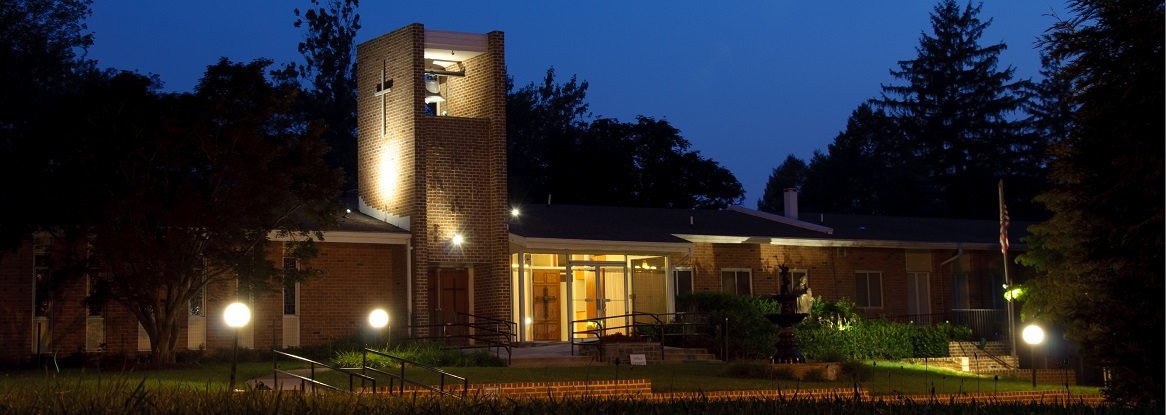

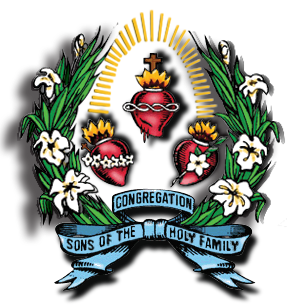










Pontifical Approval
Pontifical Approval
Pontifical Council For The Laity
Vatican
2050/87/S61/B3 a.
Decree
On 23 February, 1987, the Superior General of the Congregation of the Religious Sons of the Holy Family, Jesus, Mary, and Joseph, presented to the Cardinal President of the Pontifical Council for the Laity the new Holy Family Association Statutes for appropriate study with a request for final approval.
Endorsing the will of the Holy Father John Paul II, who "with the whole Church wishes to express veneration and love toward that Family which, thanks to the Son of God, became the 'domestic church' on earth before He founded his Church on the apostles and on Peter"1, and bearing in mind:
1. that the Holy Family Association was originally established by Pope Leo XIII with the apostolic brief Neminem Fugit, 6/14/1892, in order to spread the devotion of the Holy Family so as to bring families ever closer to Jesus, Mary, and Joseph;
2. that said Association has been repeatedly praised and recommended by all later Supreme Pontiffs, and established in many dioceses;
3. that the Congregation of the Religious Sons of the of the Holy Family, Jesus, Mary, and Joseph, founded by Blessed Joseph Manyanet in order "to promote the honor and devotion of the Holy Family so as to bring about the Christian formation of families through imitation of its virtues," and entrusted with the Secretariat of the Holy Family Association since 4/3/28, have at their most recent General Chapter of 12/86 - 1/87, reaffirmed their resolved to implement with increased spiritual and apostolic vitality its goals and activities with new Statutes;
4. that the new formulation of the Association's overall aim, which is "to spread the devotion and imitation of the Holy Family in a way that families might configure themselves with such a Model through some form of consecration," is in complete accord and harmony with Pope Leo XIII's original conception as well as with the teachings of Vatican II and of the Pontifical magisterium;
5. and that the observations indicated by the Secretariat of State on behalf of His Holiness John Paul II and by the Pontifical Council for the Family, both expressly consulted in these matters, have been faithfully incorporated into the present text of new Statutes;
this Pontifical Council for the Laity declares, by express mandate of the Holy Father, that the new Statutes of the Holy Family Association are hereby approved in accordance with Can. 314 of the Code of Canon Law, and all norms relative to public associations for the faithful are now applicable to said Association (Canons 312-320).
Vatican City, 25 November 1987 Paul J. Cordes (Vice President) Eduardo Card. Pironio (President)
Pontifical Council For The Laity
Vatican
2050/87/S61/B3 a.
Decree
On 23 February, 1987, the Superior General of the Congregation of the Religious Sons of the Holy Family, Jesus, Mary, and Joseph, presented to the Cardinal President of the Pontifical Council for the Laity the new Holy Family Association Statutes for appropriate study with a request for final approval.
Endorsing the will of the Holy Father John Paul II, who "with the whole Church wishes to express veneration and love toward that Family which, thanks to the Son of God, became the 'domestic church' on earth before He founded his Church on the apostles and on Peter"1, and bearing in mind:
1. that the Holy Family Association was originally established by Pope Leo XIII with the apostolic brief Neminem Fugit, 6/14/1892, in order to spread the devotion of the Holy Family so as to bring families ever closer to Jesus, Mary, and Joseph;
2. that said Association has been repeatedly praised and recommended by all later Supreme Pontiffs, and established in many dioceses;
3. that the Congregation of the Religious Sons of the of the Holy Family, Jesus, Mary, and Joseph, founded by Blessed Joseph Manyanet in order "to promote the honor and devotion of the Holy Family so as to bring about the Christian formation of families through imitation of its virtues," and entrusted with the Secretariat of the Holy Family Association since 4/3/28, have at their most recent General Chapter of 12/86 - 1/87, reaffirmed their resolved to implement with increased spiritual and apostolic vitality its goals and activities with new Statutes;
4. that the new formulation of the Association's overall aim, which is "to spread the devotion and imitation of the Holy Family in a way that families might configure themselves with such a Model through some form of consecration," is in complete accord and harmony with Pope Leo XIII's original conception as well as with the teachings of Vatican II and of the Pontifical magisterium;
5. and that the observations indicated by the Secretariat of State on behalf of His Holiness John Paul II and by the Pontifical Council for the Family, both expressly consulted in these matters, have been faithfully incorporated into the present text of new Statutes;
this Pontifical Council for the Laity declares, by express mandate of the Holy Father, that the new Statutes of the Holy Family Association are hereby approved in accordance with Can. 314 of the Code of Canon Law, and all norms relative to public associations for the faithful are now applicable to said Association (Canons 312-320).
Vatican City, 25 November 1987 Paul J. Cordes (Vice President) Eduardo Card. Pironio (President)
Foreword
Foreword
Today's Catholic family finds itself seriously challenged in its endeavors to establish a fellowship of life and love that is grounded on the natural bonds of flesh and blood and yet built up on the deeper and richer bonds of the Spirit and this by means through which it is able to experience its identity (what it is) and its mission (what it can and should do) according to the Creator's plan in its regard. For "in the beginning" God intended marriage as a true "partnership of man and woman with the Creator," and the family, the natural result of marriage, as a community of persons (identity) with the mission of "guarding, revealing, and communicating life and love as a living reflection of, and a real sharing in, God's love for humanity and the love of Christ for the Church, his Bride." By the very nature of things, the family experiences within itself a "summons that cannot be ignored: to become what it is meant to be."[1]
Given this divinely intended identity and mission of the family, it follows that spouses, parents and children, grandparents and relatives, are all summoned by God through the gift of faith and the grace of their sacramental charism to fulfill in concrete ways, each according to one's own gifts, the mystery of their "being family" as:
1. a community of persons, all nourished, supported, cherished and bound together in a common fellowship of life, prayer and work which realizes their full potential as individuals while bringing them to full personhood in the pursuit of the true, the good and the holy: a community of persons which itself becomes:
2. a first school, wherein are taught and learned the authentic human and social values as well as the practice of the Christian virtues, each "learning Christ"[2] as all family members are gradually formed anew in the image of God and
brought, through a progressive education and catechesis, to full human and Christian maturity;[3]
3. a church in miniature, wherein the full family comes to participate increasingly in the prophetic, priestly and kingly mission of Jesus Christ and of his Bride, the Church: a) by welcoming the Word of God in faith, by proclaiming and sharing it with others: the family becomes a "believing and evangelizing community" (prophetic mission); b) by being continuously vivified by the Lord Jesus, called and engaged by him in a dialogue with the Father through the sacraments, prayer and self-gift: the family becomes a "sanctified and sanctifying community" (priestly mission); c) by fleshing out this Word in concrete life situations according to the new commandment of love, through the observance of which we serve Christ in our fellows human beings while leading one another to that King, whom to serve is to reign: the family becomes a "reconciled and reconciling community" (kingly mission[4]);
4. a cradle of wholeness of life and holiness of love, wherein are nourished and cultivated "sacramental relationships," rich in wisdom and justice, for the discernment of the Father's will and of each person's vocation in life, be it to Christian marriage, the priesthood, the religious life, or to a single's way of living in the world as a witness to God's kingdom in the making.
Furthermore, the human family of God, Jesus, Mary and Joseph, is the divinely constituted prototype of all Christian families and, as such, is an abiding source of enlightenment, motivation, strength and courage for each family to fulfill faithfully its vocation to love and the service of life. In Nazareth, therefore, the human family finds the answers it so seeks to its deepest aspirations, hopes and dreams: it experiences their fullest realization in this process of allowing the Word of God to act on itself in such a way that the family thereafter is enabled to act on it accordingly, responding to its calling and carrying out its mission in true followership of God's
own human Family. Hence, as the model Family, the Holy Family at all times accompanies the human disciple family on its earthly pilgrimage of faith through works of hope and charity: that is, all along the arduous journey of its own sanctification as it gradually is enabled to "endure patiently" and "persevere steadfastly" in its irrevocable commitment to life and love.
Through membership in the Holy Family Association and participation in the Monthly Home Visit, the human family is initiated into an ever deepening knowledge and experience of the both the gospel and the mystery of Nazareth: during this humanly and spiritually enriching process each disciple family is slowly transformed into a new holy family and each home into a new Nazareth. And through a progressive commitment to the Holy Family, the disciple family becomes increasingly aware of a "divine empowerment" ensuing from devotion to, and imitation of, this "Earthly Trinity," which enables it to form persons in the gift of life and to practice love in all its dimensions so that "it does not live enclosed in on itself, but remains open to the community, moved by a sense of justice and concern for others, as well as by a consciousness of its responsibility towards the whole society"[5]
[1] Cf. On the Role of the Family in the Modern World, 17.
[2] Cf. Eph. 4:20 - 22
[3] Cf. Eph. 4:22 - 24
[4] lb. 49 -58,63- 64.
[5] Cf. IV Synod of Bishops, 12
Today's Catholic family finds itself seriously challenged in its endeavors to establish a fellowship of life and love that is grounded on the natural bonds of flesh and blood and yet built up on the deeper and richer bonds of the Spirit and this by means through which it is able to experience its identity (what it is) and its mission (what it can and should do) according to the Creator's plan in its regard. For "in the beginning" God intended marriage as a true "partnership of man and woman with the Creator," and the family, the natural result of marriage, as a community of persons (identity) with the mission of "guarding, revealing, and communicating life and love as a living reflection of, and a real sharing in, God's love for humanity and the love of Christ for the Church, his Bride." By the very nature of things, the family experiences within itself a "summons that cannot be ignored: to become what it is meant to be."[1]
Given this divinely intended identity and mission of the family, it follows that spouses, parents and children, grandparents and relatives, are all summoned by God through the gift of faith and the grace of their sacramental charism to fulfill in concrete ways, each according to one's own gifts, the mystery of their "being family" as:
1. a community of persons, all nourished, supported, cherished and bound together in a common fellowship of life, prayer and work which realizes their full potential as individuals while bringing them to full personhood in the pursuit of the true, the good and the holy: a community of persons which itself becomes:
2. a first school, wherein are taught and learned the authentic human and social values as well as the practice of the Christian virtues, each "learning Christ"[2] as all family members are gradually formed anew in the image of God and
brought, through a progressive education and catechesis, to full human and Christian maturity;[3]
3. a church in miniature, wherein the full family comes to participate increasingly in the prophetic, priestly and kingly mission of Jesus Christ and of his Bride, the Church: a) by welcoming the Word of God in faith, by proclaiming and sharing it with others: the family becomes a "believing and evangelizing community" (prophetic mission); b) by being continuously vivified by the Lord Jesus, called and engaged by him in a dialogue with the Father through the sacraments, prayer and self-gift: the family becomes a "sanctified and sanctifying community" (priestly mission); c) by fleshing out this Word in concrete life situations according to the new commandment of love, through the observance of which we serve Christ in our fellows human beings while leading one another to that King, whom to serve is to reign: the family becomes a "reconciled and reconciling community" (kingly mission[4]);
4. a cradle of wholeness of life and holiness of love, wherein are nourished and cultivated "sacramental relationships," rich in wisdom and justice, for the discernment of the Father's will and of each person's vocation in life, be it to Christian marriage, the priesthood, the religious life, or to a single's way of living in the world as a witness to God's kingdom in the making.
Furthermore, the human family of God, Jesus, Mary and Joseph, is the divinely constituted prototype of all Christian families and, as such, is an abiding source of enlightenment, motivation, strength and courage for each family to fulfill faithfully its vocation to love and the service of life. In Nazareth, therefore, the human family finds the answers it so seeks to its deepest aspirations, hopes and dreams: it experiences their fullest realization in this process of allowing the Word of God to act on itself in such a way that the family thereafter is enabled to act on it accordingly, responding to its calling and carrying out its mission in true followership of God's
own human Family. Hence, as the model Family, the Holy Family at all times accompanies the human disciple family on its earthly pilgrimage of faith through works of hope and charity: that is, all along the arduous journey of its own sanctification as it gradually is enabled to "endure patiently" and "persevere steadfastly" in its irrevocable commitment to life and love.
Through membership in the Holy Family Association and participation in the Monthly Home Visit, the human family is initiated into an ever deepening knowledge and experience of the both the gospel and the mystery of Nazareth: during this humanly and spiritually enriching process each disciple family is slowly transformed into a new holy family and each home into a new Nazareth. And through a progressive commitment to the Holy Family, the disciple family becomes increasingly aware of a "divine empowerment" ensuing from devotion to, and imitation of, this "Earthly Trinity," which enables it to form persons in the gift of life and to practice love in all its dimensions so that "it does not live enclosed in on itself, but remains open to the community, moved by a sense of justice and concern for others, as well as by a consciousness of its responsibility towards the whole society"[5]
[1] Cf. On the Role of the Family in the Modern World, 17.
[2] Cf. Eph. 4:20 - 22
[3] Cf. Eph. 4:22 - 24
[4] lb. 49 -58,63- 64.
[5] Cf. IV Synod of Bishops, 12
Historical Background
Historical Background
In the earliest forms of devotion to the Holy Family of Nazareth, the three Persons of Jesus, Mary, and Joseph are looked upon as the most unique model of family wholeness and holiness.
From the outset, a keen interest begins to center on the kind of interdependence that might exist between them and characterize the interactions of the three most wonderful Persons ever to have appeared on the human scene. As a result, it is not long before certain parallels and similarities are brought out between the Family of Nazareth and the Christian family, especially regarding the former's simply structured fellowship of life, prayer, and work and the latter's more socially and culturally structured existence in the world. There is early on an attempt to show that the Family of Nazareth is intended to enlighten and guide the Christian family in patterning itself after the domestic virtues so beautifully exemplified by Jesus, Mary, and Joseph.
The first attempts, therefore, at imitating the Holy Family inform a basic pattern which is followed down through the centuries: husbands, fathers, and workers look to Joseph for support and guidance; wives, mothers, and women go to Mary for strength, courage, and consolation; children, sons, and daughters find in the Child Jesus their respective Model as they move through infancy, adolescence, and early adulthood.
As more and more families adopt this form of imitation of the Holy Family, it is only a matter of time before these same families start to band together in groups, forming "confraternities," which gradually evolve into the various "Holy Family" associations that start making their appearance in the early XVII century.
The First "Associations "
One of the earliest initiatives to establish devotion to the Holy Family through the active participation of a group of people, is that
of the layperson Jerome Le Royer de la Dauversiere (1597 - 1659) in Canada: he consecrates himself, his wife, and his children to the Holy Family on the feast of the Purification in 1630. In order to look after the infirm and elderly, he decides to establish a "community", and so organizes the first Guild of the Holy Family, under the advocacy of Saint Joseph, which is promptly approved by his bishop in 1634, and canonically established the following year.
Some thirty years later, the Jesuit priest Peter Chaumonot is concerned about strengthening the family and home life throughout the surrounding area of Montreal. Together with the Governor's widow, the parish priest, and Mother Margaret Bourgoyne, he founds a Holy Family association in 1662, which has as its purpose "the sanctification of Christian families through imitation of the Family of the Word made Flesh." The spirit of the association urges all members "to form part of the Holy Family, each imitating the Person he/she represents in their own family: fathers imitating Joseph, mothers imitating Mary, and children imitating the Child Jesus."
So as to insure the existence of the association in the future, bishop Francis de Montmorency-Laval canonically approves it in 1664. On 28 January 1665, a Bull of Pope Alexander VII, and on 14 March of that same year, a Summary of Indulgences, extend to the association's full membership the necessary guarantees and privileges.
In Florence, Italy, Pope Urban VIII, on 7 February 1640, recognizing the tremendous work of the Jesuits throughout the whole surrounding area, approves, as a token of his appreciation, an association bearing the name of "Fellowship of Jesus, Mary, and Joseph."
During the following century, another Jesuit priest L. Offermans is asked to take charge of drafting the new statutes of the "Universal Association of Christian Doctrine" under the heading of "Association of Jesus, Mary, and Joseph for the Promotion of Christian Doctrine." At about this same time there appears another confraternity bearing the name of "Association of Jesus, Mary, and Joseph under the Tutelage of Saint Francis Xavier," which has as its
purpose the nurture and preservation of Christian doctrine as set forth by Popes Pius V, Paul V, and Gregory XIII.
The XIX Century
In the life of the Church during the XIX century, there appear three important associations, all bearing the name of "Holy Family," that form the historical devotional background against which Pope Leo XIII will launch his own great "Nazareth" movement to promote the Holy Family as the "Model" or "Exemplar" of all Christian families. The three associations in question are the following:
Archconfraternity Of The Holy Family
The "Archconfraternity of the Holy Family, Jesus, Mary, and Joseph," is established in Liege, Belgium, in 1844, by a certain "Captain" Bellatable, approved by the local bishop, and later by Pope Pius IX.
The association's primary emphasis is spiritual, though having at the same time certain social and humanitarian dimensions. Its main goals are to honor and imitate the Holy Family; to acquire a deeper knowledge and understanding of the faith; to live a more authentic practice of religion; to be apostles in the renewal of the family; to unify the people, the poor and the rich alike, through the corporal and spiritual works of mercy. The members bind themselves to pray together, to read and meditate on the Word of God, and to consecrate themselves to the Holy Family.
It is not long before the association expands throughout various countries of Europe and extends itself even to America, Africa, and Australia. Following the reorganization of Pope Leo XIII in 1892, the Sacred Congregation of Rites declares, on 13 February 1894, that said association is permitted to continue in existence only under the conditions that it conform to the Bull of Pope Clement VIII and that only persons, and not families, be inscribed as members.
Universal Association Of Families
The "Universal Association of Families Consecrated to the Holy Family," is founded in 1861 by the Jesuit priest Phillip Francoz at Lyon, France.
Pope Pius IX becomes immediately interested in this new movement, and writes Fr. Francoz a personal letter in 1870, congratulating him for the thousands of families already inscribed in the association.
Its main purpose is to consecrate Christian families to the Holy Family of Nazareth while promoting the renewal of sound family customs and traditions through the daily practice of the domestic virtues made manifest in Nazareth. Each consecrated family is encouraged to renew its consecration to the Holy Family each day before a picture/statue of Jesus, Mary, and Joseph.
Association Of Families Consecrated To The Holy Family
The diocesan priest Seraphim Giorgi, in Bologna, Italy, founds in 1865, the "Association of Families Consecrated to the Holy Family, Jesus, Mary, and Joseph," which Pius IX designates as the "primary" association.
This association has as its purpose also the consecration of Christian families to the Holy Family, the promotion of the spirit of prayer together in the home, the daily practice of the domestic virtues, the enthronement of a picture or statue of Jesus, Mary, and Joseph in the home, and the daily repetition of the prayer, Blessed Family of Jesus, Mary, and Joseph, enlighten us, assist us, and save us.
A Time Of Consolidation
At the century's end, these three associations and the many other smaller "Nazareth" movements emerging alongside of them pave the way for Rome to speak out more decisively on the whole matter of devotion to the Holy Family. Already in 1866, a good number of Church prelates from Italy and Spain are asking Pope Leo XIII to consecrate all Christian families of the world to the
Holy Family. The Pope, however, feels that it is not yet the appropriate time for such a worldwide consecration.
A few years later, in 1889, first Fr. Louis Biaschelli, and later Augustine Cardinal Bausa, archbishop of Florence, request from the Pope an official prayer for families to say in promoting the devotion of the Holy Family. Leo XIII responds by composing himself a "formula of consecration" for all families to recite whenever consecrating themselves to the Holy Family, together with a daily prayer to be recited before a picture or statue of Jesus, Mary, and Joseph. The Pope also firmly insists that "the virtues practiced by the Family of Nazareth are necessary for the overall well-being of both the human family and society, especially now at a time when both are being seriously threatened by evil forces. Furthermore, the common good of society, whose basic unit is the family, inexorably results from the existence of genuine Christian families."
Around this same time the Sacred Congregation of Rites takes a more serious look at solving the complex problems arising from an ever increasing number of associations bearing the name of the "Holy Family." To resolve the confusion and disorder, Leo XIII publishes his apostolic brief Neminem Fugit on 14 June 1892, by which he brings together into one single association all the existing confraternities and/or associations, notwithstanding their name, origin, purpose, or foundation. This new association is given the long title of "Universal Pious Association of Families Consecrated to the Holy Family." By so doing, the Holy Father makes it absolutely clear that "devotion to the Holy Family is not an optional practice," since Christ himself chose to be born into a human family, to grow in knowledge, are, and grace within a given household, and to begin the work of human redemption from within a home, thus demonstrating to the whole world the supreme importance of the human family institution. It is for this that he urges each Christian family to return "to Nazareth and drink from there the true spirit of genuine Christian living."
Several months later, the first Rules and Norms of the Association are published by the Pope's Cardinal Vicar, the President of the Association, who sends them out to all the bishops of the world, urging that said association be established throughout all the dioceses of the Church.
The response of the Church's prelates is unanimous, and thousands upon thousands of Christian families are consecrated to the Holy Family of Nazareth, Jesus, Mary, and Joseph. At the same time, the bishops urge the Holy Father to extend the Feast of the Holy Family, with its own proper Mass and liturgical Office, to the universal Church. The Pope responds affirmatively, setting the Feast on the first Sunday after Epiphany.
Following the initiative of Leo XIII, the succeeding Popes have all in some way recommended continued devotion to the Holy Family as the most effective means for putting Christ back into the home and building up the family. Benedict XV, summing up the teaching of his time, sets forth the meaning and purpose of such a devotion in these words: "It is just and salutary for both the family and society to nurture and spread the Association of the Holy Family ... and by this endeavor ... to honor the Family of Nazareth, celebrating the feast throughout the whole Church, and to imitate the domestic virtues while reflecting each day on the blessings this Family makes available to all of us."
The XX Century
Among the many who worked so hard during this period to further the devotion of the Holy Family, one merits special mention, possibly outshining all the others: it is the priest and founder Blessed Joseph Manyanet y Vives, S.,F., (1833 - 1901). After being ordained a priest and several years of diocesan apostolate, he decides to give himself totally and unreservedly to work for the re-Christianization of the family through the education of children and the youth. He first goes to Nazareth to dwell in spirit with Jesus, Mary, and Joseph, becoming himself a "son" of the Holy Family, then a "witness" of their virtues and holiness, later a "prophet" of the family "mystery" and "gospel" made manifest in Nazareth, and, finally, an "apostle" in the service of the human family institution.
It is his intuitive grasp of the wisdom and riches contained in Nazareth which informs the structure and content of his daily prayer life and meditation, and becomes the source of his inspiration
and resourcefulness in the unrelenting pursuit of his lifelong goal: "to make each family a 'holy family' and each home a new •Nazareth.'"
In time he founds two religious families - the Sons and Daughters of the Holy Family - as the most effective way to counteract the various evils threatening the human, spiritual, and religious welfare of the family in his own day and age. He seeks the renewal of Christian marriage and of the family primarily through the Catholic education and sound religious formation of children and youth, especially with regard to the poor and the needy. Later on in life, he states his case without ambiguity: "Urged on by the grace of God, I decided early on to devote my whole life and dedicate all my energies to accomplishing such a holy and worthwhile undertaking."
To further his proposed goal in life, Joseph Manyanet begins publication of a family monthly magazine called The Holy Family. Already in the second issue, that of 1899, Joseph Manyanet makes clear to all his followers their present and future involvement with "Nazareth": "The title of our religious family sums up our ideal. It acquaints us with who we are and where we are going. We are Sons in love with the Holy Family, and will untiringly endeavor to see It formed in the bosom of all the families. The Holy Family is our motto, our point of departure, and the goal of our aspirations."
Then on 3 April 1928, Pope Pius appoints the Congregation of the Sons of the Holy Family as the official "custodians" of the "Universal Pious Association of Families Consecrated to the Holy Family," naming the mentioned magazine as the "official mouthpiece" for all the Spanish-speaking countries.
In more recent times, the Second Vatican Council has acknowledged that both the individual and the social welfare are intimate bound up with the overall well-being of the family and the home. This underscores the fact that both Christian marriage and the family ought to be firmly rooted in the wholeness of life and the holiness of love exemplified by God's own human Family in Nazareth. In the final analysis, it will be noted that nothing contributes more effectively to the nurture, support, and strengthening of marriage and the family than the fleshing out of the
wisdom and spiritual riches hidden in the family mystery and gospel made manifest in Nazareth: for the family and its members all come to experience the uplifting and healing effect resulting from the practice of solid virtue and the presence of wholesome customs and traditions.
In the light of Pope John Paul II's pastoral concern for marriage and the family, and in the interest of carrying out the recommendations of the fifth Synod of bishops also on the family, a decision is made to update and simplify the name and the statutes of the existing "Universal Pious Association of Families Consecrated to the Holy Family." Upon completion of this undertaking, the Superior General of the Congregation of the Sons of the Holy Family forwards with a cover Letter to Ugo Cardinal Poleti, dated 8 September 1980, the revised and updated Rules and Statutes of the renamed "Association of the Holy Family." Within a few days, the new Rules and Statutes are accepted and approved by said Cardinal in Rome, Italy.
Even more recently, however, after several years of renewed study and work regarding the continuing problematic and deteriorating situation of marriage and the family in the contemporary world, an increasingly serious and urgent need is felt throughout the above-mentioned religious Congregation of the Sons of the Holy Family to adopt a totally new approach to the Association and restructure its whole purpose, mission, and organization.
A decision is made to this effect, and the work begins of restating in clearer terms the Association's theological foundation, its nature and purpose, its duties and responsibilities as well as that of restructuring its organization and levels of involvement and commitment. The task is finally completed in time to be reviewed by those elected to attend the XVIII General Chapter of the Sons of the Holy Family in Barcelona, Spain.
In January 1987, the Chapter Fathers respond affirmative to the new focus, format, content and restructuring. The new document is then forwarded to Rome for final approval, which is obtained in November 1987. And for now, and the foreseeable future, both the Sons and the (Missionary) Daughters of the Holy Family are
irrevocably committed to its fullest dissemination and implementation. This booklet is just one of many efforts being made to carry out this commitment on behalf of the family and the Church in today's world
In the earliest forms of devotion to the Holy Family of Nazareth, the three Persons of Jesus, Mary, and Joseph are looked upon as the most unique model of family wholeness and holiness.
From the outset, a keen interest begins to center on the kind of interdependence that might exist between them and characterize the interactions of the three most wonderful Persons ever to have appeared on the human scene. As a result, it is not long before certain parallels and similarities are brought out between the Family of Nazareth and the Christian family, especially regarding the former's simply structured fellowship of life, prayer, and work and the latter's more socially and culturally structured existence in the world. There is early on an attempt to show that the Family of Nazareth is intended to enlighten and guide the Christian family in patterning itself after the domestic virtues so beautifully exemplified by Jesus, Mary, and Joseph.
The first attempts, therefore, at imitating the Holy Family inform a basic pattern which is followed down through the centuries: husbands, fathers, and workers look to Joseph for support and guidance; wives, mothers, and women go to Mary for strength, courage, and consolation; children, sons, and daughters find in the Child Jesus their respective Model as they move through infancy, adolescence, and early adulthood.
As more and more families adopt this form of imitation of the Holy Family, it is only a matter of time before these same families start to band together in groups, forming "confraternities," which gradually evolve into the various "Holy Family" associations that start making their appearance in the early XVII century.
The First "Associations "
One of the earliest initiatives to establish devotion to the Holy Family through the active participation of a group of people, is that
of the layperson Jerome Le Royer de la Dauversiere (1597 - 1659) in Canada: he consecrates himself, his wife, and his children to the Holy Family on the feast of the Purification in 1630. In order to look after the infirm and elderly, he decides to establish a "community", and so organizes the first Guild of the Holy Family, under the advocacy of Saint Joseph, which is promptly approved by his bishop in 1634, and canonically established the following year.
Some thirty years later, the Jesuit priest Peter Chaumonot is concerned about strengthening the family and home life throughout the surrounding area of Montreal. Together with the Governor's widow, the parish priest, and Mother Margaret Bourgoyne, he founds a Holy Family association in 1662, which has as its purpose "the sanctification of Christian families through imitation of the Family of the Word made Flesh." The spirit of the association urges all members "to form part of the Holy Family, each imitating the Person he/she represents in their own family: fathers imitating Joseph, mothers imitating Mary, and children imitating the Child Jesus."
So as to insure the existence of the association in the future, bishop Francis de Montmorency-Laval canonically approves it in 1664. On 28 January 1665, a Bull of Pope Alexander VII, and on 14 March of that same year, a Summary of Indulgences, extend to the association's full membership the necessary guarantees and privileges.
In Florence, Italy, Pope Urban VIII, on 7 February 1640, recognizing the tremendous work of the Jesuits throughout the whole surrounding area, approves, as a token of his appreciation, an association bearing the name of "Fellowship of Jesus, Mary, and Joseph."
During the following century, another Jesuit priest L. Offermans is asked to take charge of drafting the new statutes of the "Universal Association of Christian Doctrine" under the heading of "Association of Jesus, Mary, and Joseph for the Promotion of Christian Doctrine." At about this same time there appears another confraternity bearing the name of "Association of Jesus, Mary, and Joseph under the Tutelage of Saint Francis Xavier," which has as its
purpose the nurture and preservation of Christian doctrine as set forth by Popes Pius V, Paul V, and Gregory XIII.
The XIX Century
In the life of the Church during the XIX century, there appear three important associations, all bearing the name of "Holy Family," that form the historical devotional background against which Pope Leo XIII will launch his own great "Nazareth" movement to promote the Holy Family as the "Model" or "Exemplar" of all Christian families. The three associations in question are the following:
Archconfraternity Of The Holy Family
The "Archconfraternity of the Holy Family, Jesus, Mary, and Joseph," is established in Liege, Belgium, in 1844, by a certain "Captain" Bellatable, approved by the local bishop, and later by Pope Pius IX.
The association's primary emphasis is spiritual, though having at the same time certain social and humanitarian dimensions. Its main goals are to honor and imitate the Holy Family; to acquire a deeper knowledge and understanding of the faith; to live a more authentic practice of religion; to be apostles in the renewal of the family; to unify the people, the poor and the rich alike, through the corporal and spiritual works of mercy. The members bind themselves to pray together, to read and meditate on the Word of God, and to consecrate themselves to the Holy Family.
It is not long before the association expands throughout various countries of Europe and extends itself even to America, Africa, and Australia. Following the reorganization of Pope Leo XIII in 1892, the Sacred Congregation of Rites declares, on 13 February 1894, that said association is permitted to continue in existence only under the conditions that it conform to the Bull of Pope Clement VIII and that only persons, and not families, be inscribed as members.
Universal Association Of Families
The "Universal Association of Families Consecrated to the Holy Family," is founded in 1861 by the Jesuit priest Phillip Francoz at Lyon, France.
Pope Pius IX becomes immediately interested in this new movement, and writes Fr. Francoz a personal letter in 1870, congratulating him for the thousands of families already inscribed in the association.
Its main purpose is to consecrate Christian families to the Holy Family of Nazareth while promoting the renewal of sound family customs and traditions through the daily practice of the domestic virtues made manifest in Nazareth. Each consecrated family is encouraged to renew its consecration to the Holy Family each day before a picture/statue of Jesus, Mary, and Joseph.
Association Of Families Consecrated To The Holy Family
The diocesan priest Seraphim Giorgi, in Bologna, Italy, founds in 1865, the "Association of Families Consecrated to the Holy Family, Jesus, Mary, and Joseph," which Pius IX designates as the "primary" association.
This association has as its purpose also the consecration of Christian families to the Holy Family, the promotion of the spirit of prayer together in the home, the daily practice of the domestic virtues, the enthronement of a picture or statue of Jesus, Mary, and Joseph in the home, and the daily repetition of the prayer, Blessed Family of Jesus, Mary, and Joseph, enlighten us, assist us, and save us.
A Time Of Consolidation
At the century's end, these three associations and the many other smaller "Nazareth" movements emerging alongside of them pave the way for Rome to speak out more decisively on the whole matter of devotion to the Holy Family. Already in 1866, a good number of Church prelates from Italy and Spain are asking Pope Leo XIII to consecrate all Christian families of the world to the
Holy Family. The Pope, however, feels that it is not yet the appropriate time for such a worldwide consecration.
A few years later, in 1889, first Fr. Louis Biaschelli, and later Augustine Cardinal Bausa, archbishop of Florence, request from the Pope an official prayer for families to say in promoting the devotion of the Holy Family. Leo XIII responds by composing himself a "formula of consecration" for all families to recite whenever consecrating themselves to the Holy Family, together with a daily prayer to be recited before a picture or statue of Jesus, Mary, and Joseph. The Pope also firmly insists that "the virtues practiced by the Family of Nazareth are necessary for the overall well-being of both the human family and society, especially now at a time when both are being seriously threatened by evil forces. Furthermore, the common good of society, whose basic unit is the family, inexorably results from the existence of genuine Christian families."
Around this same time the Sacred Congregation of Rites takes a more serious look at solving the complex problems arising from an ever increasing number of associations bearing the name of the "Holy Family." To resolve the confusion and disorder, Leo XIII publishes his apostolic brief Neminem Fugit on 14 June 1892, by which he brings together into one single association all the existing confraternities and/or associations, notwithstanding their name, origin, purpose, or foundation. This new association is given the long title of "Universal Pious Association of Families Consecrated to the Holy Family." By so doing, the Holy Father makes it absolutely clear that "devotion to the Holy Family is not an optional practice," since Christ himself chose to be born into a human family, to grow in knowledge, are, and grace within a given household, and to begin the work of human redemption from within a home, thus demonstrating to the whole world the supreme importance of the human family institution. It is for this that he urges each Christian family to return "to Nazareth and drink from there the true spirit of genuine Christian living."
Several months later, the first Rules and Norms of the Association are published by the Pope's Cardinal Vicar, the President of the Association, who sends them out to all the bishops of the world, urging that said association be established throughout all the dioceses of the Church.
The response of the Church's prelates is unanimous, and thousands upon thousands of Christian families are consecrated to the Holy Family of Nazareth, Jesus, Mary, and Joseph. At the same time, the bishops urge the Holy Father to extend the Feast of the Holy Family, with its own proper Mass and liturgical Office, to the universal Church. The Pope responds affirmatively, setting the Feast on the first Sunday after Epiphany.
Following the initiative of Leo XIII, the succeeding Popes have all in some way recommended continued devotion to the Holy Family as the most effective means for putting Christ back into the home and building up the family. Benedict XV, summing up the teaching of his time, sets forth the meaning and purpose of such a devotion in these words: "It is just and salutary for both the family and society to nurture and spread the Association of the Holy Family ... and by this endeavor ... to honor the Family of Nazareth, celebrating the feast throughout the whole Church, and to imitate the domestic virtues while reflecting each day on the blessings this Family makes available to all of us."
The XX Century
Among the many who worked so hard during this period to further the devotion of the Holy Family, one merits special mention, possibly outshining all the others: it is the priest and founder Blessed Joseph Manyanet y Vives, S.,F., (1833 - 1901). After being ordained a priest and several years of diocesan apostolate, he decides to give himself totally and unreservedly to work for the re-Christianization of the family through the education of children and the youth. He first goes to Nazareth to dwell in spirit with Jesus, Mary, and Joseph, becoming himself a "son" of the Holy Family, then a "witness" of their virtues and holiness, later a "prophet" of the family "mystery" and "gospel" made manifest in Nazareth, and, finally, an "apostle" in the service of the human family institution.
It is his intuitive grasp of the wisdom and riches contained in Nazareth which informs the structure and content of his daily prayer life and meditation, and becomes the source of his inspiration
and resourcefulness in the unrelenting pursuit of his lifelong goal: "to make each family a 'holy family' and each home a new •Nazareth.'"
In time he founds two religious families - the Sons and Daughters of the Holy Family - as the most effective way to counteract the various evils threatening the human, spiritual, and religious welfare of the family in his own day and age. He seeks the renewal of Christian marriage and of the family primarily through the Catholic education and sound religious formation of children and youth, especially with regard to the poor and the needy. Later on in life, he states his case without ambiguity: "Urged on by the grace of God, I decided early on to devote my whole life and dedicate all my energies to accomplishing such a holy and worthwhile undertaking."
To further his proposed goal in life, Joseph Manyanet begins publication of a family monthly magazine called The Holy Family. Already in the second issue, that of 1899, Joseph Manyanet makes clear to all his followers their present and future involvement with "Nazareth": "The title of our religious family sums up our ideal. It acquaints us with who we are and where we are going. We are Sons in love with the Holy Family, and will untiringly endeavor to see It formed in the bosom of all the families. The Holy Family is our motto, our point of departure, and the goal of our aspirations."
Then on 3 April 1928, Pope Pius appoints the Congregation of the Sons of the Holy Family as the official "custodians" of the "Universal Pious Association of Families Consecrated to the Holy Family," naming the mentioned magazine as the "official mouthpiece" for all the Spanish-speaking countries.
In more recent times, the Second Vatican Council has acknowledged that both the individual and the social welfare are intimate bound up with the overall well-being of the family and the home. This underscores the fact that both Christian marriage and the family ought to be firmly rooted in the wholeness of life and the holiness of love exemplified by God's own human Family in Nazareth. In the final analysis, it will be noted that nothing contributes more effectively to the nurture, support, and strengthening of marriage and the family than the fleshing out of the
wisdom and spiritual riches hidden in the family mystery and gospel made manifest in Nazareth: for the family and its members all come to experience the uplifting and healing effect resulting from the practice of solid virtue and the presence of wholesome customs and traditions.
In the light of Pope John Paul II's pastoral concern for marriage and the family, and in the interest of carrying out the recommendations of the fifth Synod of bishops also on the family, a decision is made to update and simplify the name and the statutes of the existing "Universal Pious Association of Families Consecrated to the Holy Family." Upon completion of this undertaking, the Superior General of the Congregation of the Sons of the Holy Family forwards with a cover Letter to Ugo Cardinal Poleti, dated 8 September 1980, the revised and updated Rules and Statutes of the renamed "Association of the Holy Family." Within a few days, the new Rules and Statutes are accepted and approved by said Cardinal in Rome, Italy.
Even more recently, however, after several years of renewed study and work regarding the continuing problematic and deteriorating situation of marriage and the family in the contemporary world, an increasingly serious and urgent need is felt throughout the above-mentioned religious Congregation of the Sons of the Holy Family to adopt a totally new approach to the Association and restructure its whole purpose, mission, and organization.
A decision is made to this effect, and the work begins of restating in clearer terms the Association's theological foundation, its nature and purpose, its duties and responsibilities as well as that of restructuring its organization and levels of involvement and commitment. The task is finally completed in time to be reviewed by those elected to attend the XVIII General Chapter of the Sons of the Holy Family in Barcelona, Spain.
In January 1987, the Chapter Fathers respond affirmative to the new focus, format, content and restructuring. The new document is then forwarded to Rome for final approval, which is obtained in November 1987. And for now, and the foreseeable future, both the Sons and the (Missionary) Daughters of the Holy Family are
irrevocably committed to its fullest dissemination and implementation. This booklet is just one of many efforts being made to carry out this commitment on behalf of the family and the Church in today's world
Statues
Statutes
Article 1: Nature And Purpose
Instituted by Pope Leo XIII on 14 June 1892, the Holy Family Association is an official gathering of Christian families whose specific purpose is "to promote the honor, imitation and devotion of the Holy Family in a way that all families might come to model themselves after the Family of Nazareth" through an approved form of consecration[1].
In this way the Association makes its own the constant concern the Church has always shown for the family, and proposes the Holy Family "as the prototype of all Christian families as well as the living gospel of all the values that today's families are to live and proclaim"[2].
Whatever the Christian revelation, therefore, has to say about marriage and the family ~ just as it is proclaimed by the Church's teaching authority - constitutes the Association's very foundation.
Article 2: Spirituality
The Association takes its inspiration from the founding charism of the religious Sons of the Holy Family, Jesus, Mary, and Joseph, and shares in their own way of life and apostolate, which is "to model themselves after the Holy Family and make real Blessed Joseph Manyanet's motto: "A Nazareth in each home," so as to build up mature human Christian families, thus contributing in a most singular way to the good of society and the Church.
Every family, couple and single person who, responding to a call from God, assume membership in the Association, embark upon a journey of gradual configuration with the Family of
Nazareth as the Ideal of their own lives and families. All members commit themselves wholeheartedly, in a personal and communal way, to fulfill their conjugal and family mission in life, growing in faith, hope, and love while making the Holy Family the object of their daily contemplation and the model of their prayer life, domestic fellowship, and apostolic endeavors.
Article 3: Consecration To The Holy Family
All members live out a specific form of consecration to the Holy Family by means of which, individually and as a family, they gradually come to form a community of disciples, witnesses, and apostles of the Holy Family of Nazareth:
Disciples of Nazareth by welcoming into their homes the Holy Family as the source of inspiration for their life-project
Witnesses of Nazareth by fleshing out in their own conjugal and family lives the Christian values present in the Holy Family
Apostles of Nazareth by proclaiming through word and deed the richness of these values to other families
Article 4: Disciples Of Nazareth
By assuming membership in the Association, the family strives to be a community of disciples of Nazareth who listen to, reflect upon and exemplify in practice the Word of God as that Word revealed Itself in the domestic life of Jesus, Mary and Joseph. In order to accomplish this triple objective.
4.1 The Family: Domestic Church. Each family of the Association reflects on God's design for the family as made manifest in the Holy Family[3], and commits itself to pray individually and collectively that God will enable it to live out faithfully its dignity
and responsibility of being a family, a domestic church, in accordance with the teaching of the magisterium10.
4.2 The Family: Hope of Society. Member families of the Association read and share the Scriptures as a way of deepening their faith, witnessing to it, and passing it on to their children in a more authentic manner. Likewise, each family welcomes in a responsible way children born into it as gifts from God, educates them through the achievement of human and Christian maturity, and directs them in life according to their own vocation, even if God should call them to a life of special consecration to Him and service in the Church.
Article 5 : Witnesses Of Nazareth
By its act of consecration to the Holy Family, each family commits itself to form a community of witnesses of Nazareth, who, through common fellowship, undergo in the home the spiritual experience of the life and sanctify of the Holy Family.
The Family: School of the Gospel. Imbued with the Spirit of Christ and enlightened by the example of Nazareth, all members, in carrying out their personal or conjugal and family vocation and mission in life, mutually support one another in personality development and the work of ongoing sanctification. Through dialogue and reciprocal love, they make God present in the home and work place, and, little by little imbue it with the spirit of the Family of Nazareth: authentic school of life and domestic virtues11.
The Family: Home, Temple and Workshop. Each person and family live their "Nazareth" consecration by mirroring through their personal, conjugal and family lifestyles the fellowship of life, prayer and work of the Family of Nazareth through:
• Interpersonal relationships rooted in faith and expressed with care and love
Prayerful attitudes leading to intimate communion with God
Responsible commitment to the demands of each one's personal calling in life
All parents, aware of being the first and foremost educators of their children, make every effort possible to ensure their Christian education, offering by their own way of life an enduring example grounded on the values of truth, freedom, justice and love[4].
Article 6: Apostles Of Nazareth
Each family, which becomes through its consecration a community of disciples and witnesses of Nazareth, is also called to be a community of apostles of Nazareth by radiating the Gospel, received and lived out in the home, as witnesses to other families, in the surrounding area, and in work place[5].
The Family: Community of Life and Love. Family members endeavor to make of their own family a true community of life and love, each one according to their situation: husband and wife, through faithful conjugal love and mutual self-giving at all levels of their life; parents and children, through ongoing interchanges of love by which each gives and receives[6] acceptance, forbearance, reconciliation and peace[7].
The Family: Educator of Families. Married members of the Association actively involve themselves in the pastoral work of preparing young people for sacramental marriage, helping them to discern the calling to marriage and to embrace the mission of fatherhood and motherhood within the Christian family[8].
They are especially sensitive toward newlyweds, more exposed to possible difficulties in adopting to a life in common and the acceptance of children[9]. They also consider it to be their mission
to be at the side of couples experiencing moments of crisis so as better to support them with their own expertise and with the means that a caring Church and wise pedagogy advise.
The Family: Promoter of Life. All members of the Association commit themselves to defend life from conception until natural death; to encourage the practice of adoption and collaborate, according to their means, in providing assistance to children who have lost their parents or have been abandoned by them[10].
The Family: Service of Charity. Each family and member of the Association tries to carry out at home, in the parish, or within the Association itself, both spiritual and corporal works of mercy toward the poor, those without work, the sick, the elderly, the handicapped, the addicted, the orphans, the widows, the abandoned spouses, and the unmarried mothers[11].
Article 7: Membership In The Association
Christian families and all persons who consecrate themselves to the Holy Family and embrace as their own the way of the Association in accordance with their state in life, are members of the Association. The commitments assumed do not bind of themselves under penalty of sin.
Consecration to the Holy Family is accomplished by reciting in public the approved formula in the presence of the pastor or properly designated priest. The consecrated family is then inscribed in the Association's record book. The national Council will issue a corresponding certificate of membership[12].
Article 8 : Holy Family Statue Or Picture In The Home
All members frequently gather around a properly displayed statue or picture of the Holy Family, which presides over all in the
home, to pray and to reflect on the Word of God[13]. Married couples renew before it their covenanted commitment of life and love and fidelity whenever celebrating anniversaries. All families will endeavor to keep alive the experience of their unique fellowship, particularly on occasions of family celebrations.
Article 9 : Monthly Home Visit By The Holy Family
A unique means by which the members of the Association might bind themselves together in a more stable fellowship and to the Holy Family is the Monthly Home Visit by which the Holy Family goes from one home to another amongst the members of the Association[14].
The practical application of this wonderful traditional devotion should be accommodated to the culture and customs of each country and adapted to each area's urban and rural needs, as the norms so indicate.
Article 10: Doctrinal, Spiritual And Moral Formation
The Association provides its members with an ongoing doctrinal, spiritual, and moral program of formation, fulfilling this task itself when and wherever possible or facilitating its implementation through other institutions which are capable and willing to meet this need of the membership[15].
Article 11: Spiritual Life Program
The Association establishes for its members a developmental spiritual life program which is meant to nourish and strengthen their faith, witness, and apostolic activity. The primary means recommended are:
• Active participation in the celebration of the Eucharist
Frequent celebration of the sacrament of Reconciliation
Recitation of the full Rosary, or at least of part of it
Daily spiritual visits to "Nazareth" in order "to see what Jesus, Mary and Joseph are doing and listen to what they are saying"[16]
Celebration of the Liturgy of the Hours, adapted to family use, especially on specified days.
The presence of religious signs and symbols in the home, such as a crucifix, the Advent wreath, a Nativity creche, etc.[17].
Article 12: Main Feasts of The Association
All members of the Association celebrate in a special way the following feast days:
Feast of the Holy Family (the Sunday after Christmas)
Feast of the Immaculate Conception (8 December)
Feast of Saint Joseph (19 March)
Feast of Saint Joseph Manyanet (16 December).
On the Feast of the Holy Family all members renew their act of consecration to the Family of Nazareth. Likewise, all member families will accentuate wedding anniversaries and other family celebrations as opportunities to offer God praise and thanks, to seek divine assistance and intervention, and to reaffirm their fidelity to all commitments properly entered into[18].
Article 13: The Association And The Sons Of The Holy Family
In a concerted effort to live ever more fully the Christian life according to the spirit of the Family of Nazareth, all members of the Association find inspiration, direction and assistance from within the religious Institute of the Sons of the Holy Family.
They unite themselves with these professed religious by way of a singular bond through which they become an integral part of Saint Joseph Manyanet's religious family.
The Institute's Superior General, in agreement with his General Council, sets forth the criteria for such a bonding.
Article 14: The Association's Spiritual Blessings
All members of the Association may gain a plenary indulgence, under the usual conditions (confession, communion and prayers for the Holy Father), on the following days:
When being consecrated to the Holy Family
When renewing annual consecration
When celebrating anniversaries
On the feasts of the Holy Family, Immaculate Conception, Saint Joseph and Saint Joseph Manyanet27.
Article 15: Family Day And Prayers For Deceased Members
Every Wednesday the Association's spiritual advisers, in spirit with all the associates, celebrate Family Day, which ends with the celebration of the Eucharist.
On the last Wednesday of each month the Sacrifice of the Mass is offered for the eternal repose of the Association's deceased members.
Article 16: Compatibility With Other Movements And Organizations
The Holy Family Association is compatible with other parish movements and organizations, since its purpose is simply to enlighten the human family on its calling and mission in the Church and the world from the specific spiritual viewpoint of the Family of Nazareth[19].
Article 17: Under The Direction Of The Families Themselves
The Holy Family Association, as a grouping of families for the sake of families, remains always under the direction of the families themselves and a priest adviser.
The Association promotes its goals by means of periodic meetings and encounters with the families in small groups, assemblies, and congresses.
The Association is structured at the parochial, the diocesan, the national, and the worldwide levels through the establishment of directional councils on each level[20]. The couples making up these councils have each one vote per individual on all issues to be decided by ballot.
Article 18: The Parochial Council
All members at the parochial level elect three couples who form the parochial council, which is to promote and implement the Association's goals, always in consultation with pastor or the priest designated as the parochial spiritual adviser of the Association. The
parochial council also maintains with the diocesan council whatever contact or interchanges the Association's dynamics require at that level[21]
Article 19: The Diocesan Council
In each diocese there exists a diocesan council, which is to promote and implement the Association's goals throughout the diocese. This council is formed by three couples and a priest designated as the diocesan spiritual adviser, who is presented to the bishop by the Association's secretary general. The couples are elected from among the members forming the parochial councils, always in consultation with the diocesan spiritual adviser[22].
Article 20: The National Council
The diocesan councils are unified and coordinated by a national council, which heads the Association and implements its goals within a given country. The national council is formed by three couples and a priest properly designated as the Association's national spiritual adviser, who is appointed by the Association's secretary general. The three couples are elected from among the members forming the diocesan councils, always in consultation with the national spiritual adviser.
Article 21: The Worldwide Council
The national councils are subordinated to a worldwide council, which oversees the Association's promotion and implementation of its goals on a worldwide basis. This council, presided over by the Superior General of the Institute of the religious Sons of the Holy Family, Jesus, Mary and Joseph, is also formed by three couples and a priest properly designated by said Institute as the Association's secretary general. The three couples are elected from among the members forming the national councils, always in
consultation with the above-mentioned religious Institute[23].
Article 22: Other "Holy Family " Institutes And Congregations
The worldwide council elicits from all other Institutes or Congregation bearing the title of "Holy Family" support and cooperation with the Association, and asks that each provide, within the areas where they exist, encouragement and spiritual assistance to its members.
The Association, for its part, carries out, according to the circumstances of time and place, concrete programs and activities with such Institutes or Congregations in line with the Association's objectives and spirituality and those of the Institutes or Congregations themselves.
Article 23: Family Presence And Social Communications
The Association's worldwide and national councils, as well as the diocesan and parochial councils, employ, each at their respective levels, whatever ways and means are deemed necessary, yet appropriate, for promoting the Association and implementing its
goals[24].
In a most special way the Association strives to ensure in today's world the presence of sound Christian family values throughout the social communications network, particularly within the audiovisual areas, given the profound influence such means have on contemporary society.
Article 24: Rome As The Association's Headquarters
The Association's Worldwide Council and International Spiritual Center have their Headquarters in Rome, Italy, at the
Parochial Temple of the Holy Family of Nazareth, established by the express wish of Pope Pius XII to be a "bright beacon and most solid foundation of the devotion to the Family of Nazareth"[25]. This International Temple is provided for all the world's Christian families.
Article 25: "Holy Family Magazine" As Official Mouthpiece
The Holy Family Magazine is the Association's official mouthpiece for the countries in whose languages it is published. The Magazine is at the service of the aims and goals of the Association, seeking, throughout its pages, to foster and develop the life of the Association and bring to light those Christian life experiences which might prove useful to other families in today's world.
All the Association's members consider this publication as a unique source for valuable information, and frequently collaborate with it by submitting written articles on family matters, especially family and spiritual life formation[26].
Article 26: Organizational And Promotional Expenses
Families, couples and single members help meet the financial burden for promoting and operating the Association by means of an voluntary annual contribution made to their respective parochial councils.
The diocesan, national and worldwide councils are subsidized by an established quota mutually agreed upon by the councils themselves. Other opportune and appropriate measures may also be used to defray general expenses.
All positions of responsibility and spiritual assistance are voluntary and for a three year term that is renewable.
' Leo XIII, Neminem fugit, 6/14/1892; Estatutos Generates (EG), 1936, 1.
[2] JPII, Speech to the Cardinals, 12122179.
[3] JP II, Homily, 12131178.
" FC 36, 37.
" Paul VI, Evangelii nuntiandi, 71; FC 52.
[6] FC 21.
" FC 58.
[8] FC 66.
[9] FC 69.
ieFC41.
iS FC 71.
[12] EG 1.4.
[13] EG 1.4.
[14] Pius IX, Letter to Fr. F. Francoz, 5/1/1870; Pius XII, Letter to Fr. Martin Millet, S.F., 218157.
[15] FC 65.
[16] Joseph Manyanet, The Spirit of the Holy Family, 1.21.46.
[17] FC 61.
[18] EG 5.
26 Neminem fugit (1892).
[20] EG 3.4.
[21] EG 4.
3* EG 4.
[23] EG 3; Decree from the Roman Vicariate, 4/3/28.
[24] EG 4.
[25] EG 2; Pius XII, Lettere to Fr. Martin Millet, S.F., 8/2/57.
3i Basilio Cardinal Pompili, Letter to Fr. Jaime Mir, S.F. 1/2/29
Article 1: Nature And Purpose
Instituted by Pope Leo XIII on 14 June 1892, the Holy Family Association is an official gathering of Christian families whose specific purpose is "to promote the honor, imitation and devotion of the Holy Family in a way that all families might come to model themselves after the Family of Nazareth" through an approved form of consecration[1].
In this way the Association makes its own the constant concern the Church has always shown for the family, and proposes the Holy Family "as the prototype of all Christian families as well as the living gospel of all the values that today's families are to live and proclaim"[2].
Whatever the Christian revelation, therefore, has to say about marriage and the family ~ just as it is proclaimed by the Church's teaching authority - constitutes the Association's very foundation.
Article 2: Spirituality
The Association takes its inspiration from the founding charism of the religious Sons of the Holy Family, Jesus, Mary, and Joseph, and shares in their own way of life and apostolate, which is "to model themselves after the Holy Family and make real Blessed Joseph Manyanet's motto: "A Nazareth in each home," so as to build up mature human Christian families, thus contributing in a most singular way to the good of society and the Church.
Every family, couple and single person who, responding to a call from God, assume membership in the Association, embark upon a journey of gradual configuration with the Family of
Nazareth as the Ideal of their own lives and families. All members commit themselves wholeheartedly, in a personal and communal way, to fulfill their conjugal and family mission in life, growing in faith, hope, and love while making the Holy Family the object of their daily contemplation and the model of their prayer life, domestic fellowship, and apostolic endeavors.
Article 3: Consecration To The Holy Family
All members live out a specific form of consecration to the Holy Family by means of which, individually and as a family, they gradually come to form a community of disciples, witnesses, and apostles of the Holy Family of Nazareth:
Disciples of Nazareth by welcoming into their homes the Holy Family as the source of inspiration for their life-project
Witnesses of Nazareth by fleshing out in their own conjugal and family lives the Christian values present in the Holy Family
Apostles of Nazareth by proclaiming through word and deed the richness of these values to other families
Article 4: Disciples Of Nazareth
By assuming membership in the Association, the family strives to be a community of disciples of Nazareth who listen to, reflect upon and exemplify in practice the Word of God as that Word revealed Itself in the domestic life of Jesus, Mary and Joseph. In order to accomplish this triple objective.
4.1 The Family: Domestic Church. Each family of the Association reflects on God's design for the family as made manifest in the Holy Family[3], and commits itself to pray individually and collectively that God will enable it to live out faithfully its dignity
and responsibility of being a family, a domestic church, in accordance with the teaching of the magisterium10.
4.2 The Family: Hope of Society. Member families of the Association read and share the Scriptures as a way of deepening their faith, witnessing to it, and passing it on to their children in a more authentic manner. Likewise, each family welcomes in a responsible way children born into it as gifts from God, educates them through the achievement of human and Christian maturity, and directs them in life according to their own vocation, even if God should call them to a life of special consecration to Him and service in the Church.
Article 5 : Witnesses Of Nazareth
By its act of consecration to the Holy Family, each family commits itself to form a community of witnesses of Nazareth, who, through common fellowship, undergo in the home the spiritual experience of the life and sanctify of the Holy Family.
The Family: School of the Gospel. Imbued with the Spirit of Christ and enlightened by the example of Nazareth, all members, in carrying out their personal or conjugal and family vocation and mission in life, mutually support one another in personality development and the work of ongoing sanctification. Through dialogue and reciprocal love, they make God present in the home and work place, and, little by little imbue it with the spirit of the Family of Nazareth: authentic school of life and domestic virtues11.
The Family: Home, Temple and Workshop. Each person and family live their "Nazareth" consecration by mirroring through their personal, conjugal and family lifestyles the fellowship of life, prayer and work of the Family of Nazareth through:
• Interpersonal relationships rooted in faith and expressed with care and love
Prayerful attitudes leading to intimate communion with God
Responsible commitment to the demands of each one's personal calling in life
All parents, aware of being the first and foremost educators of their children, make every effort possible to ensure their Christian education, offering by their own way of life an enduring example grounded on the values of truth, freedom, justice and love[4].
Article 6: Apostles Of Nazareth
Each family, which becomes through its consecration a community of disciples and witnesses of Nazareth, is also called to be a community of apostles of Nazareth by radiating the Gospel, received and lived out in the home, as witnesses to other families, in the surrounding area, and in work place[5].
The Family: Community of Life and Love. Family members endeavor to make of their own family a true community of life and love, each one according to their situation: husband and wife, through faithful conjugal love and mutual self-giving at all levels of their life; parents and children, through ongoing interchanges of love by which each gives and receives[6] acceptance, forbearance, reconciliation and peace[7].
The Family: Educator of Families. Married members of the Association actively involve themselves in the pastoral work of preparing young people for sacramental marriage, helping them to discern the calling to marriage and to embrace the mission of fatherhood and motherhood within the Christian family[8].
They are especially sensitive toward newlyweds, more exposed to possible difficulties in adopting to a life in common and the acceptance of children[9]. They also consider it to be their mission
to be at the side of couples experiencing moments of crisis so as better to support them with their own expertise and with the means that a caring Church and wise pedagogy advise.
The Family: Promoter of Life. All members of the Association commit themselves to defend life from conception until natural death; to encourage the practice of adoption and collaborate, according to their means, in providing assistance to children who have lost their parents or have been abandoned by them[10].
The Family: Service of Charity. Each family and member of the Association tries to carry out at home, in the parish, or within the Association itself, both spiritual and corporal works of mercy toward the poor, those without work, the sick, the elderly, the handicapped, the addicted, the orphans, the widows, the abandoned spouses, and the unmarried mothers[11].
Article 7: Membership In The Association
Christian families and all persons who consecrate themselves to the Holy Family and embrace as their own the way of the Association in accordance with their state in life, are members of the Association. The commitments assumed do not bind of themselves under penalty of sin.
Consecration to the Holy Family is accomplished by reciting in public the approved formula in the presence of the pastor or properly designated priest. The consecrated family is then inscribed in the Association's record book. The national Council will issue a corresponding certificate of membership[12].
Article 8 : Holy Family Statue Or Picture In The Home
All members frequently gather around a properly displayed statue or picture of the Holy Family, which presides over all in the
home, to pray and to reflect on the Word of God[13]. Married couples renew before it their covenanted commitment of life and love and fidelity whenever celebrating anniversaries. All families will endeavor to keep alive the experience of their unique fellowship, particularly on occasions of family celebrations.
Article 9 : Monthly Home Visit By The Holy Family
A unique means by which the members of the Association might bind themselves together in a more stable fellowship and to the Holy Family is the Monthly Home Visit by which the Holy Family goes from one home to another amongst the members of the Association[14].
The practical application of this wonderful traditional devotion should be accommodated to the culture and customs of each country and adapted to each area's urban and rural needs, as the norms so indicate.
Article 10: Doctrinal, Spiritual And Moral Formation
The Association provides its members with an ongoing doctrinal, spiritual, and moral program of formation, fulfilling this task itself when and wherever possible or facilitating its implementation through other institutions which are capable and willing to meet this need of the membership[15].
Article 11: Spiritual Life Program
The Association establishes for its members a developmental spiritual life program which is meant to nourish and strengthen their faith, witness, and apostolic activity. The primary means recommended are:
• Active participation in the celebration of the Eucharist
Frequent celebration of the sacrament of Reconciliation
Recitation of the full Rosary, or at least of part of it
Daily spiritual visits to "Nazareth" in order "to see what Jesus, Mary and Joseph are doing and listen to what they are saying"[16]
Celebration of the Liturgy of the Hours, adapted to family use, especially on specified days.
The presence of religious signs and symbols in the home, such as a crucifix, the Advent wreath, a Nativity creche, etc.[17].
Article 12: Main Feasts of The Association
All members of the Association celebrate in a special way the following feast days:
Feast of the Holy Family (the Sunday after Christmas)
Feast of the Immaculate Conception (8 December)
Feast of Saint Joseph (19 March)
Feast of Saint Joseph Manyanet (16 December).
On the Feast of the Holy Family all members renew their act of consecration to the Family of Nazareth. Likewise, all member families will accentuate wedding anniversaries and other family celebrations as opportunities to offer God praise and thanks, to seek divine assistance and intervention, and to reaffirm their fidelity to all commitments properly entered into[18].
Article 13: The Association And The Sons Of The Holy Family
In a concerted effort to live ever more fully the Christian life according to the spirit of the Family of Nazareth, all members of the Association find inspiration, direction and assistance from within the religious Institute of the Sons of the Holy Family.
They unite themselves with these professed religious by way of a singular bond through which they become an integral part of Saint Joseph Manyanet's religious family.
The Institute's Superior General, in agreement with his General Council, sets forth the criteria for such a bonding.
Article 14: The Association's Spiritual Blessings
All members of the Association may gain a plenary indulgence, under the usual conditions (confession, communion and prayers for the Holy Father), on the following days:
When being consecrated to the Holy Family
When renewing annual consecration
When celebrating anniversaries
On the feasts of the Holy Family, Immaculate Conception, Saint Joseph and Saint Joseph Manyanet27.
Article 15: Family Day And Prayers For Deceased Members
Every Wednesday the Association's spiritual advisers, in spirit with all the associates, celebrate Family Day, which ends with the celebration of the Eucharist.
On the last Wednesday of each month the Sacrifice of the Mass is offered for the eternal repose of the Association's deceased members.
Article 16: Compatibility With Other Movements And Organizations
The Holy Family Association is compatible with other parish movements and organizations, since its purpose is simply to enlighten the human family on its calling and mission in the Church and the world from the specific spiritual viewpoint of the Family of Nazareth[19].
Article 17: Under The Direction Of The Families Themselves
The Holy Family Association, as a grouping of families for the sake of families, remains always under the direction of the families themselves and a priest adviser.
The Association promotes its goals by means of periodic meetings and encounters with the families in small groups, assemblies, and congresses.
The Association is structured at the parochial, the diocesan, the national, and the worldwide levels through the establishment of directional councils on each level[20]. The couples making up these councils have each one vote per individual on all issues to be decided by ballot.
Article 18: The Parochial Council
All members at the parochial level elect three couples who form the parochial council, which is to promote and implement the Association's goals, always in consultation with pastor or the priest designated as the parochial spiritual adviser of the Association. The
parochial council also maintains with the diocesan council whatever contact or interchanges the Association's dynamics require at that level[21]
Article 19: The Diocesan Council
In each diocese there exists a diocesan council, which is to promote and implement the Association's goals throughout the diocese. This council is formed by three couples and a priest designated as the diocesan spiritual adviser, who is presented to the bishop by the Association's secretary general. The couples are elected from among the members forming the parochial councils, always in consultation with the diocesan spiritual adviser[22].
Article 20: The National Council
The diocesan councils are unified and coordinated by a national council, which heads the Association and implements its goals within a given country. The national council is formed by three couples and a priest properly designated as the Association's national spiritual adviser, who is appointed by the Association's secretary general. The three couples are elected from among the members forming the diocesan councils, always in consultation with the national spiritual adviser.
Article 21: The Worldwide Council
The national councils are subordinated to a worldwide council, which oversees the Association's promotion and implementation of its goals on a worldwide basis. This council, presided over by the Superior General of the Institute of the religious Sons of the Holy Family, Jesus, Mary and Joseph, is also formed by three couples and a priest properly designated by said Institute as the Association's secretary general. The three couples are elected from among the members forming the national councils, always in
consultation with the above-mentioned religious Institute[23].
Article 22: Other "Holy Family " Institutes And Congregations
The worldwide council elicits from all other Institutes or Congregation bearing the title of "Holy Family" support and cooperation with the Association, and asks that each provide, within the areas where they exist, encouragement and spiritual assistance to its members.
The Association, for its part, carries out, according to the circumstances of time and place, concrete programs and activities with such Institutes or Congregations in line with the Association's objectives and spirituality and those of the Institutes or Congregations themselves.
Article 23: Family Presence And Social Communications
The Association's worldwide and national councils, as well as the diocesan and parochial councils, employ, each at their respective levels, whatever ways and means are deemed necessary, yet appropriate, for promoting the Association and implementing its
goals[24].
In a most special way the Association strives to ensure in today's world the presence of sound Christian family values throughout the social communications network, particularly within the audiovisual areas, given the profound influence such means have on contemporary society.
Article 24: Rome As The Association's Headquarters
The Association's Worldwide Council and International Spiritual Center have their Headquarters in Rome, Italy, at the
Parochial Temple of the Holy Family of Nazareth, established by the express wish of Pope Pius XII to be a "bright beacon and most solid foundation of the devotion to the Family of Nazareth"[25]. This International Temple is provided for all the world's Christian families.
Article 25: "Holy Family Magazine" As Official Mouthpiece
The Holy Family Magazine is the Association's official mouthpiece for the countries in whose languages it is published. The Magazine is at the service of the aims and goals of the Association, seeking, throughout its pages, to foster and develop the life of the Association and bring to light those Christian life experiences which might prove useful to other families in today's world.
All the Association's members consider this publication as a unique source for valuable information, and frequently collaborate with it by submitting written articles on family matters, especially family and spiritual life formation[26].
Article 26: Organizational And Promotional Expenses
Families, couples and single members help meet the financial burden for promoting and operating the Association by means of an voluntary annual contribution made to their respective parochial councils.
The diocesan, national and worldwide councils are subsidized by an established quota mutually agreed upon by the councils themselves. Other opportune and appropriate measures may also be used to defray general expenses.
All positions of responsibility and spiritual assistance are voluntary and for a three year term that is renewable.
' Leo XIII, Neminem fugit, 6/14/1892; Estatutos Generates (EG), 1936, 1.
[2] JPII, Speech to the Cardinals, 12122179.
[3] JP II, Homily, 12131178.
" FC 36, 37.
" Paul VI, Evangelii nuntiandi, 71; FC 52.
[6] FC 21.
" FC 58.
[8] FC 66.
[9] FC 69.
ieFC41.
iS FC 71.
[12] EG 1.4.
[13] EG 1.4.
[14] Pius IX, Letter to Fr. F. Francoz, 5/1/1870; Pius XII, Letter to Fr. Martin Millet, S.F., 218157.
[15] FC 65.
[16] Joseph Manyanet, The Spirit of the Holy Family, 1.21.46.
[17] FC 61.
[18] EG 5.
26 Neminem fugit (1892).
[20] EG 3.4.
[21] EG 4.
3* EG 4.
[23] EG 3; Decree from the Roman Vicariate, 4/3/28.
[24] EG 4.
[25] EG 2; Pius XII, Lettere to Fr. Martin Millet, S.F., 8/2/57.
3i Basilio Cardinal Pompili, Letter to Fr. Jaime Mir, S.F. 1/2/29

